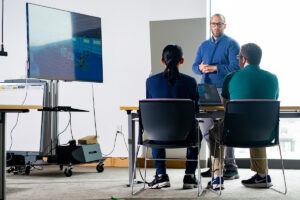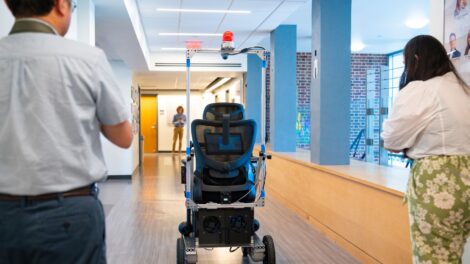Gamifying STEM education
By Madeline Marriott ’24
In collaboration with Christian Lopez, assistant professor of computer science, affiliated with mechanical engineering, Aidan Mathieu ’26 and Wilson Hong ’26 are creating game-based learning models to support the production engineering training process.
The research is funded by a grant from the National Science Foundation (NSF) in collaboration with team members at Pennsylvania State University and Carnegie Mellon University. The grant —the first of its kind for Lopez— funds three years of student collaboration. Since joining the project in late 2023 and early 2024, respectively, Mathieu and Hong have been working on creating a simulated version of a water bottling factory that can be used as a model to teach undergraduate and graduate engineering students about the fundamentals of production.
 In addition to providing a more immersive learning experience, the technology can help to eliminate barriers to use as it does not require access to specialized equipment.
In addition to providing a more immersive learning experience, the technology can help to eliminate barriers to use as it does not require access to specialized equipment.
After over a year of building the environment, the team is now working toward introducing pedagogical content to the simulation, including visual explanations of the mathematical theories, how to look for signs of problems in the machines, and tips for adapting to fix these problems.
“I find the challenge of optimizing the game to be exciting,” Mathieu says. “We’re trying to make a simulation that requires a lot of compute resources, with bottles being able to fall to the ground and issues with the factory that are interesting for the project. Learning the techniques to make it more optimized has been interesting to me.”
Hong most enjoys the mission-based design for the quests that occur at the end of every level. According to Lopez, whose research interests include a wide range of persuasive technologies, aside from its function as a motivation tactic, the gamification of the learning process is also “intertwined with the pedagogical aspects.”
“First, you learn about a concept, and then we assess if you really understood it,” Lopez says. “We assess works to help you practice the skill, but also to make sure that you’re following along.”
The project has been a lesson in collaboration and organization for Mathieu and Hong who have been on the team through many of its stages of development.
“I’ve seen that the beginning of a project and choices you make then are super important,” Hong says. “Being involved in those decisions by looking at the benefits and drawbacks of the software was a new organizational experience for me.”
 “In our classes, we get some experience collaborating with partners on projects, but those are normally only a few weeks,” Mathieu adds. “When you have the chance to work on more of a long-term project like this, you get more experience with development and refinements as you add more and more features, and you learn more about how things might come together on future projects.”
“In our classes, we get some experience collaborating with partners on projects, but those are normally only a few weeks,” Mathieu adds. “When you have the chance to work on more of a long-term project like this, you get more experience with development and refinements as you add more and more features, and you learn more about how things might come together on future projects.”
The group hopes the model can be used in the classrooms of their collaborators at Penn State, which offers an industrial engineering major. The team has tracked their work through YouTube videos that show the model’s progress, from early iterations showing the introduction of the forklift to their more recent updates with a mobile human avatar and the addition of levels and a tutorial system.
Mathieu and Hong recently presented this work alongside other Lafayette student researchers at the National Conference for Undergraduate Research (NCUR) in Pittsburgh.
This material is based upon work supported by the National Science Foundation under Award No. 2302815.

